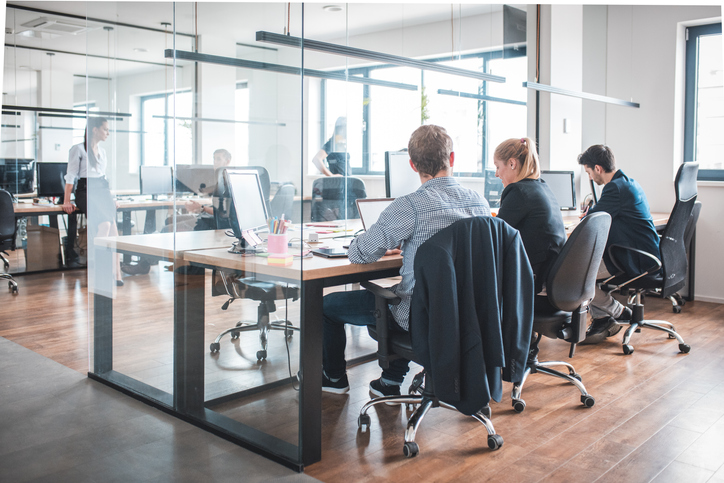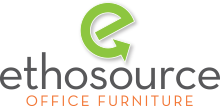When it comes to what the office of the future will look like, there’s a lot to talk about. The modern workplace is continuously evolving, but the very abrupt need for evolution that all business owners faced more recently caused some challenges.
Despite the hurdles, our remote work “experiment” has taught us a lot about the most effective ways to work — and that they’re not the same for everyone. As a result, one of the most popular solutions to make the workplace work again is designing one that blends the benefits of remote work and collaborative space all in one: the hybrid office.

Like we said, there’s a lot to talk about here. So we’ve broken up our deep dive into the hybrid office into a three-part series, starting with what it is, how it works, and what challenges to prepare for.
What is the Hybrid Office?
To answer this simply, a hybrid model has employees working both in-office and remotely. In a survey by Deloitte, 34% of the workers anticipate having more flexibility and autonomy to decide when and how to perform their work in today’s work environment. According to Microsoft, 70% of employees want more remote work options, while 65% want more time in-person with their teams. With numbers like that, we also know there are a lot of people who want both.
As a result, two-thirds of decision-makers are considering redesigning their spaces to accommodate hybrid work. This type of environment offers flexibility and freedom in a number of different forms. For one business, it could be a fixed office space with various work areas, while for another it could mean a dynamic workspace with rotating time slots. It could also be different for each employee. For some, it may mean coming in only for team brainstorms or client meetings; for another, it may mean being remote Tuesdays and Thursdays.
The good news is that designing for every work style isn’t as painful as it used to be. Office furniture has become as versatile and adaptable as we’ve proved to be — but more on that in Parts Two and Three.
So What are the Benefits?
-
Productivity is Boosted
When your employees feel they have a more flexible work schedule, they tend to put in more effort while they work. 77% of remote employees have tracked higher performance and increased productivity (CoSo Cloud). By offering a better work-life balance and/or fewer distractions from colleagues, a hybrid office gives employees more options to suit their specific work styles without sacrificing the benefits of face-to-face interactions.
-
Employees are Happier
Everyone’s homelife looks different. For a younger employee, escaping an apartment full of roommates may be their preferred way to get things done. For employees with young kids, working remotely may minimize the stress of juggling childcare, chores, and afterschool activities.
A flexible workspace offers benefits to everyone, whether it’s less time commuting and more time with family, or it’s strengthening team connections with in-person collaboration and social interaction. Improving the employee experience will make people happier, more motivated, and more likely to stick around.
-
Costs are Lower
Hybrid offices save you big in a number of ways. Reducing your office square footage cuts back on real estate costs, as well as monthly electric and WiFi bills. With less employees in the office every single day, you can also not only save on typical office supplies, but even more so on furniture and equipment too. Designing for a hybrid model allows you to get creative with less permanent solutions like shared spaces and mobile options that maximize your investment.
-
Talent Pools are Larger
If your hybrid model fully embraces remote work for certain employees, then this opens a major door to a global talent pool in your hiring process. Finding the best people for your team can now mean hiring solely based on skills and experience without the geographical limitations of a physical space.
Recognizing the Challenges of a Hybrid Office
With all the perks of having a lot more flexibility comes some challenges too (of course). There’s a reason some structure can be a good thing, and that’s definitely something to keep in mind when designing your hybrid model.
With employees both in the office and at home, it can be harder to manage team progress and identify when things are going off track. Communication becomes more important than ever, which means right tools and software to keep your teams connected and streamline your workflow. Everyone should be able to easily access coworker schedules, check in on tasks, reach out for help, and conduct meetings or discussions — just like they would in the office.
And while team-building activities like team lunches, happy hours, and company outings are essential for creating trust and community within a company, it’s not so easy when half your team is at home. In a hybrid model, remote employees can feel disconnected or left out which can be harmful to their morale and productivity. Be mindful of how to plan these culture-oriented events by offering virtual “get togethers” or team games and activities, or plan for in-person meet ups in various locations that include everyone. You’ll have to get creative!
The hybrid office is not a one-size-fits-all solution, and it’s up to you to make it work for your team. But Ethosource can help. Stay tuned for Part Two of our Hybrid Office of the Future series to learn more about designing a hybrid environment for success.
